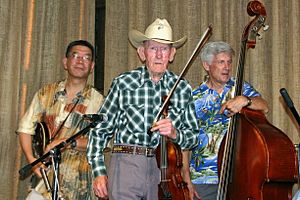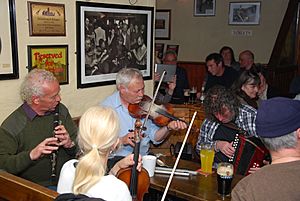Fiddle facts for kids
A fiddle is basically a violin used in folk music. Many people use the word "fiddle" as a fun, informal way to say "violin." Someone who plays the fiddle is called a "fiddler." The stick used to play it, called a bow, is sometimes known as a "fiddling stick." Fiddle playing, or fiddling, is a special kind of folk music.
The word fiddle also describes older instruments. These instruments existed hundreds of years ago. They eventually developed into the modern violin. These old fiddles looked different in various countries. They also changed over time. They came in many shapes and sizes. They even had different names. Often, players held them against their chest. They did not tuck them under their chin.
In the Middle Ages, there was a tiny, thin violin called a kit. Dance teachers often used it. It was so small it could fit in a pocket! In southeastern Europe, some fiddles had a front part (called the belly) made of skin. Fiddle strings were usually made from gut.
Contents
How Fiddles Are Different
Many fiddles have bridges that are flatter on top. Classical violins have more curved bridges. A flatter bridge makes it easier to play chords. It also helps players move the bow quickly between strings. Fiddle strings can be tuned in many ways. A player might even change the tuning for different songs.
Common tunings include G-D-G-D or A-E-A-E. The standard violin tuning is G-D-A-E. Sometimes, one, two, or three strings are used for a drone. A drone is a continuous note. The player then plays the main tune on the other string or strings.
Many fiddlers learn by listening. They copy other fiddlers instead of taking classical lessons. The music they play is often for dancing. Classical violin playing actually grew from country fiddle playing. Most fiddlers use bows similar to violin bows. But in some countries, like Hungary, they use shorter, heavier bows. These bows have horse hair tied around the frog. The frog is the heel of the bow. With this bow, the player tightens the hair by squeezing it while playing.
Fiddlers Through History
People from all parts of society played fiddles. This included noble people and simple peasants. Many fiddlers were minstrels. Minstrels were entertainers for important people. Some minstrels could read music. But many learned by copying others. They memorized the tunes.
At big feasts, minstrels sometimes played music. They would walk to the main table as food was brought in. They played to accompany dancers and singers. They even played for acrobats. Old paintings show them playing with other instruments. These included trumpets, drums, or percussion.
We don't know exactly what music they played. It was often not written down. But some tunes we hear today might come from those old songs. People still learn tunes by ear. They learn from others who learned by ear, and so on. Some American "old-time" tunes are like this. Some Breton tunes may have come to us in this way too.
Playing Fiddles Together
Usually, you see a solo fiddler playing. Or maybe one or two fiddlers with other musicians. This is common in North American, Scandinavian, Scottish, and Irish styles. Sometimes, two fiddlers play together.
After the folk music revivals in the late 1900s, large groups of fiddlers started playing together. This happens in less formal settings. Examples include the Calgary Fiddlers. Also, Swedish Spelmanslag folk-musician clubs are popular. The worldwide trend of Irish sessions also features many fiddlers.
In contrast, orchestral violins are grouped into sections. These are called "chairs." These different traditions show how music was played long ago. Large concert halls needed more instruments. This was before electronic sound systems. Fiddlers played in smaller dance halls and homes. These places needed fewer instruments.
The sounds expected from violin music and fiddle music were also different. Historically, most fiddle music was for dancing. Violin music either grew from dance music or was something else entirely. Violin music valued a smooth sound. Fiddling, with its clear dance beat, did not always follow this. If more volume was needed, a fiddler could play harder. A violinist might not do this. Different fiddle traditions have different values for their sound.
Other Pages to Explore
Images for kids
-
Silvestre Vargas (1901-1985), fiddler of the Mariachi Vargas from 1921 to 1975, director from 1931 to 1955
-
Chasi, a Warm Springs Apache musician, playing the Apache fiddle, 1886
See also
 In Spanish: Violín tradicional para niños
In Spanish: Violín tradicional para niños








